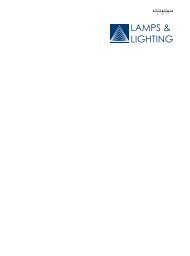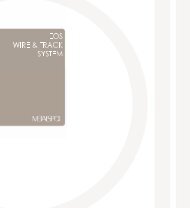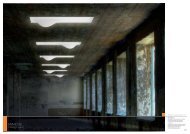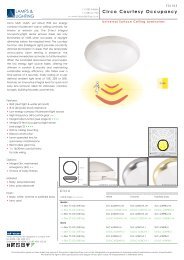LED 2009 - Lamps & Lighting Ltd
LED 2009 - Lamps & Lighting Ltd
LED 2009 - Lamps & Lighting Ltd
Create successful ePaper yourself
Turn your PDF publications into a flip-book with our unique Google optimized e-Paper software.
NOME PRODOTTO<br />
DESIGN GESIGN 0000<br />
i<br />
Codice Code 05<br />
Codice Code 06<br />
Codice Code 07<br />
Codice Code 08<br />
Blu<br />
Blue<br />
Rosso<br />
Red<br />
Ambra<br />
Amber<br />
Verde<br />
Green<br />
COLOUR TEMPERATURE.<br />
The colour temperature of a lighting source is the numeric expression of its chromatic<br />
appearance. It’s based on the principle that any object, if heated at a sufficiently high<br />
temperature, emits a light, and the colour of that light will vary in a predictable way, according<br />
to the rising of the temperature. The colour temperature of a lighting source is the temperature<br />
measured in kelvins (K), at which a heated black-body radiator matches the colour of light; for an<br />
example a <strong>LED</strong> with a 4000°K colour temperature has a chromatic appearance similar to an object<br />
heated at 4000°K (3727°C).<br />
HUE.<br />
Colour temperature describes very well what hue is. These are the main groups in which it’s<br />
divided: Warm White, Neutral White, and Cold White.<br />
COLOUR RENDERING.<br />
Artificial lighting must guarantee an as correct as possible colour perception (the closest as<br />
possible to daylight), depending on where its used and what the expectations are.<br />
The index of colour rendering is the measure of the concordance between a colour and how it’s<br />
actually perceived if observed under the referred lighting source.<br />
The index of colour rendering, Ra, is 100 if the source produces exactly the same effect of lighting<br />
source taken as reference. Higher is the difference of colour rendering between our source and<br />
the one taken as reference, lower is the Ra index.<br />
RGB.<br />
Acronym for Red/Green/Blue. It’s the additive colour model in which red, green and blue light are<br />
added together thus determining any other colour, including white. Colour and tone control can<br />
be obtained with a button, remote control or a DMX 512 protocol.<br />
11








